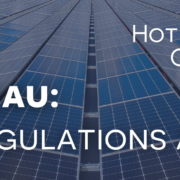Can the U.S. Senate Save Us Now?: A Call for Action
/0 Comments/in Blog, Clean Energy, Climate, UncategorizedCan the U.S. Senate Save Us Now?: A Call for Action
/0 Comments/in Blog, Clean Energy, Climate, UncategorizedProtect Voting Rights: What’s at Stake for Alaskans Right Now
/0 Comments/in Blog, Clean Energy, Climate, UncategorizedThe Future of Clean Energy Tax Credits: The Next Big Fight in D.C.
/0 Comments/in Blog, Clean Energy, Climate, UncategorizedWe’re Almost Through! Your Last Minute Guide to Election Day
/in Blog, Clean Energy, Climate, DemocracyDear Friends,
If you haven’t voted yet, and especially if you’re not sure how you’ll be voting, this is a deeply abbreviated catch-up-to-speed that tries to put all the important information we’ve sent about this year’s elections into one place.
Federal elections: You might have heard that there’s a consequential presidential race happening—you should vote! And while that’s important, we focus our work a lot closer to home. The Alaska Center has endorsed Mary Peltola for Alaska’s sole seat in the US Congress. Congressman Mary Peltola is the only candidate in the race who shares our vision of a thriving, just, and sustainable future, and we hope she returns to Washington to continue her good work!
State Legislative elections: Every voter in Alaska gets to vote for their State Representative this year, and half of the voters get to decide on your State Senator (Senate terms are longer than Representative terms, and only half are up each cycle). We’ve endorsed a suite of candidates here—they’re organized by district. (Not sure what your district is? Enter your address in this form to find your current officials and their district numbers/letters.) We talk about state legislative elections a lot because they impact so much: like how easy it is to vote, where our energy comes from, and how much we invest in our public education system. (Also: do you like more than one candidate? Great! Rank them!)
Ballot Measures: We’ve made endorsements on both of the ballot proposals this year. Voting Yes on 1 is a vote in favor of increasing the minimum wage to $15 over 4 years, requiring employers to provide paid sick leave, and protecting worker freedom. Voting No on 2 is a vote in favor of protecting Alaska’s voting system which includes open primaries, ensuring that Alaskans (most of whom are not registered with any political party) can have their full voice heard at the polls.
Judicial Retention Elections: The last thing on the ballot are judicial retention elections. Alaska does not elect judges—instead, we vote to retain appointed judges. An independent, nonpartisan commission (the Alaska Judicial Council) conducts a rigorous investigation of each judge and makes recommendations. They’ve recommended retaining every judge up this year. (Want to learn more? Our previous guest-authored blog is a great starting point.)
Phew! That’s it! There’s more information on our endorsements page here.
The most important thing you can do, whether you plan to vote in agreement with the above recommendations or not, is to get out and vote. The second most important thing: tell your friends, family, neighbors, and your community.
Thank you so much for being a voter.
With hopes for a bright future,
Jenny-Marie Stryker
Political Director
The Alaska Center
Beyond Juneau: Renewable Regulations and You!
/in Blog, Clean EnergyIf you joined us in celebrating some major policy wins with us this summer, you may have started to wonder what comes next. While we set our sights on our next policy goals for 2025, we also have important opportunities to continue to move toward a clean energy future for Alaska by engaging in the world of regulations.
On August 13, Community Solar was signed into law by Governor Dunleavy. Now, the Regulatory Commission of Alaska (RCA) has one year from the effective date to determine exactly how this program will function. The RCA regulates public utilities and pipeline carriers throughout the state, making decisions about rates, compliance with regulations, quality of service, safety, and more. In addition to support staff and analysts, the RCA is structured to be led by five full-time Commissioners, but currently only has four serving Commissioners.
With our partners, we have written about some of the specific decisions the RCA will need to make, including whether to extend its full net metering policy to community energy facilities so that subscribers are equitably compensated for the energy produced. As the RCA considers exactly how Community Solar will be structured, we encourage members of the public to make their voices heard. At the beginning of each biweekly public meeting of the RCA, members of the public are invited to speak for up to five minutes. During this period, you can introduce yourself and make a comment about Community Solar, clean energy, or anything else relevant to their work (as long as it is not related to an open docket).
Meanwhile, the Railbelt Reliability Council (RRC) is also making key decisions in the world of renewable regulations. This body, created by the legislature to create a more reliable and efficient railbelt energy system, is directed by a fourteen member board of stakeholders with an interest in railbelt reliability, representing the state’s Alaska Energy Authority, consumer advocates, environmental advocates, independent power producers, the electric utilities, and unaffiliated representatives.
The RRC has been moving forward toward the creation of an Integrated Resource Plan (IRP) for the railbelt, which will lay out the energy priorities for the railbelt for a twenty year period. This process includes identifying how much renewable energy should be brought online, what transmission and grid upgrades are necessary for proper integration and exchange of renewable energy, and how to ensure the overall system functions well (or how to ensure reliability across the system). Each of the railbelt utilities has created or will create their own version of an IRP, but an overarching plan will be an opportunity to build out the railbelt’s renewable energy generation most efficiently.
This multi-year planning process is underway with the Board currently working on establishing certain reliability standards that must be created before an Integrated Resource Plan is completed. The RRC currently aims to begin the IRP process in earnest by the first half of 2025, and complete that in a year. Additionally, the RRC’s Public Involvement Committee has been working hard to create clear opportunities for public outreach and engagement throughout this process.
Members of the public are always welcome to attend RRC Board meetings or Public Involvement Committee meetings, and to give feedback to the Board during the public comment section of their meetings. Information about upcoming meetings, including agendas, can be found on the RRC website.
Interested in learning more about the regulatory process or attending one of these meetings with support? Email Alex at alex@akcenter.org or stay tuned for future opportunities.
With energy for the future,
The Alaska Center
The Alaska Impact of the Inflation Reduction Act, Two Years Later
/in Blog, Clean Energy, OpEdThis Op-Ed was originally published in the Anchorage Daily News on August 14, 2024. It is authored by our board members, Gavin Dixon and Griffin Plush, who share their insights on the impact of the Inflation Reduction Act on Alaska over the past two years.
Two years ago this week, the Inflation Reduction Act (IRA) was signed, marking a generational investment in energy and climate infrastructure. This funding is now beginning to flow into Alaska, benefitting our homes and communities in myriad ways. With numerous new tax credit programs, financing tools, and grant funding opportunities, the IRA has created so many funding opportunities that people are beginning to take advantage of all across our great state.
Alaskans are starting to benefit from the IRA through a wide variety of programs, including rebates on new efficient appliances such as stoves, dryers, heat pumps and water heaters; tax credits for home energy efficiency improvements; and expanded tax benefits for installing renewable energy and battery energy storage on homes. These new programs help keep money in Alaskans’ pockets, encourage job creation and investment in our homes and businesses, and help reduce energy costs. These direct energy and financial improvements for individuals will be even more important to help mitigate the negative impacts of escalating energy costs on the Railbelt due to the natural gas crisis in Cook Inlet.
Beyond the individual tax credits, the IRA has also established Direct Pay, a system for non-taxpaying organizations such as nonprofits, Tribes, local governments and utility cooperatives to benefit from these clean energy tax incentives for the first time. By enabling creative financing options like this, we are starting to see movement toward clean energy across sectors.
New financing and grant opportunities have also been secured for Alaskans, with many millions more to come. The Alaska Energy Authority and Tanana Chiefs Conference and their partners Alaska Housing Finance Corporation and the Alaska Native Tribal Health Consortium together received more than $120 million from the IRA’s Solar for All Program, which will support rooftop solar, community solar programs and utility-scale solar for communities all around Alaska primarily benefiting low-income residents and Tribes over the next five years. Golden Valley Electric Association received $100 million from the IRA’s Powering Affordable Clean Energy to develop grid infrastructure that will improve reliability and enable the development of large-scale solar in Nenana. Southeast Conference received nearly $40 million from the IRA’s Climate Pollution Reduction Grant Program to install thousands of residential heat pumps all over southeast Alaska to reduce energy use and heating costs for residents. These infrastructure projects will reduce energy costs, create thousands of good-paying jobs, and help to improve the resilience of our electrical systems across Alaska. That’s to say nothing of IRA investments in fisheries research and protection, forest fire mitigation programs, transportation infrastructure and much more.
Alaskans are excited to see the investments of the IRA propel Alaska’s transition towards more sustainable, local and clean energy. We look forward to communities and families around the state fully leveraging the IRA. We are thankful to the federal and state agencies working to implement these programs correctly, and to the elected officials, like Sen. Lisa Murkowski and Rep. Mary Peltola, who continue to support these smart investments that build the framework for growing our state’s clean energy economy, fighting the impacts of a changing climate, and building a brighter, more resilient future for us all.
– Gavin Dixon and Griffin Plush volunteer together as board members of The Alaska Center; they are both lifelong Alaskans who work professionally with energy projects across the state.
New Name, Same Old Coal
/in Blog, Clean Energy, ClimateThis month, a company named Flatlands Energy has been making the rounds at Southcentral Alaska’s electric utilities, cheerily describing a future where coal power is safe and environmentally responsible. We know better. The vision they present of “carbon capture and storage” on a coal power plant relies on unproven technology and a number of false assumptions, and Alaskans are smart enough to see through these claims and refuse new coal development in our state.
While the rest of the United States, and most advanced economies throughout the world, are working to phase out coal usage, Flatlands proposes developing a brand new coal power plant in Matanuska-Susitna Borough. This is not a conversation about mitigating the emissions from existing projects – this would be starting from scratch with coal, fully aware of its many environmental and health impacts. A new open-pit coal mine along with a power plant fitted with carbon capture infrastructure would be constructed near the proposed pipeline to Donlin Mine.
Carbon capture technology on power plants has not been proven successful. In fact, existing projects have been consistently under-performing when it comes to the actual carbon captured. Notably, Flatlands claimed during its presentation at Chugach Electric Association that coal with carbon capture would put out lower emissions than even wind and solar with natural gas backup. However, that claim relies on the system capturing a whopping 90% of carbon emissions, which is completely unrealistic. Petra Nova, the only coal plant to operate with carbon capture in the United States, also aimed for a 90% capture, but likely only captured 55-70% of emissions while it was online. Including methane emissions from coal mining itself also significantly drops the amount of carbon that can be captured.
What’s more, these projects fail consistently on economics alone. Even with substantial government funding, carbon capture projects have not been profitable. Flatlands bets on a future of tax credits that is not guaranteed, and key players like the Mat Su Borough Assembly claim this will reduce the cost of importing liquefied natural gas (LNG). However, a new coal mine and coal power plant would certainly not be online soon enough to offset LNG imports.
Instead of getting distracted by false promises, our electric utilities should continue their work to conserve as much gas as possible and move toward the most cost-effective mix of energy for the Railbelt, which includes 76% renewable energy generation.
Alaskans will not be fooled: coal power is the past, not our future.









